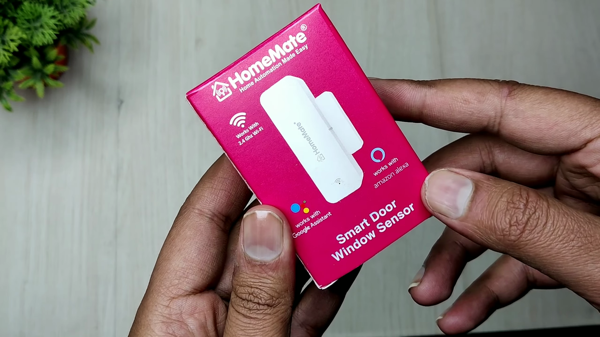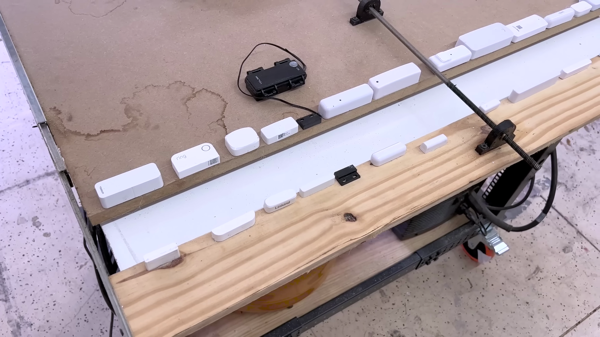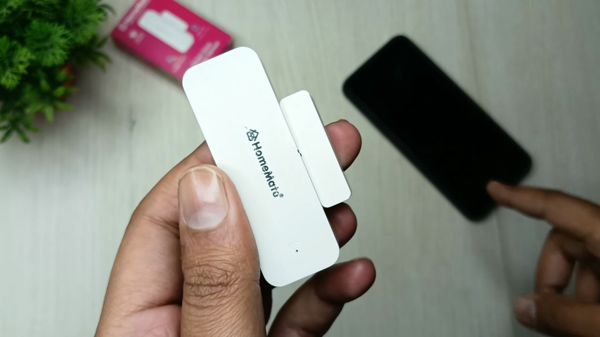Note: As an Amazon Associate I earn from qualifying purchases.
ORIKLON: great WiFi smart door / window that is compatible with Alexa and Google (2024)
Introduction
I recently added the ORIKLON WiFi Door Sensor Twin Pack to my smart home system. I was looking for a device that offered security while maintaining a simple design, which can be quite hard to find.
Specifications
| Property | Value | Property | Value |
|---|---|---|---|
| Brand | ORIKLON | Power Source | Battery Powered |
| Compatible Devices | Home Security System | Number of Batteries | 2 AAA batteries required. |
| Control Method | App, Voice |
Photos
Click on photos to enlarge them:
Prices
Check prices of the WiFi Smart Door/Window Sensor 2 Pack - Alexa/Google Compatible on:
Initial Setup Experience

Switching to a smart home security system, I opted for the ORIKLON WiFi Door Sensor Twin Pack, looking to integrate an easy-to-install, cost-effective solution to my setup. My initial setup experience with these sensors was mixed but ultimately satisfying, considering the features they offer at their price point. Here’s a summary based on the steps I followed:
Ensure 2.4G WiFi compatibility and connectivity; disabling 5G temporarily.
Ensure the router isn’t preventing the device from connecting using its MAC address.
Maintain a strong WiFi signal and proximity during setup.
Use the Smartlife or Tuya app for hassle-free installation.
Use Bluetooth for a easier and uninterrupted connection.
The process of adding the sensor was straightforward. The app’s user-friendly interface guided me through the steps in a straightforward manner, making the task efficient and hassle-free. No hub was required, which was appreciated for reducing clutter and keeping the setup straightforward.
The voice control works well with Alexa and Google Assistant. It lets me check my doors and windows with simple voice commands, integrating my smart ecosystem effectively. This feature feels advanced and convenient.
However, the sensor’s requirement to use only 2.4G WiFi might cause issues for some users. They may be unaware of their router settings or unfamiliar with WiFi bands. Moreover, initially turning off 5G to pair the device seemed outdated, but afterwards, switching back to dual-band usage was easy.
During the pairing process, a momentary disconnection was an issue I encountered. The easy adhesive installation required minimal physical effort, making the setup process straightforward. However, the sensor’s larger size and increased weight raised concerns about long-term adherence to various surfaces. Keep a close eye on this aspect over time.
Yet, the ease of app notifications and lack of complicated wiring outweighed any issues I had, resulting in a generally favorable setup experience. Although some reviews mentioned connectivity problems and slow smart alerts, my dual sensors connected after a few attempts and have been consistent in sending activity alerts since then.
Of course, I have high hopes for these sensors based on their easy installation for smart home security. However, I will evaluate their performance over time in terms of responsiveness and battery life.
Smart Security Integration

As a tech enthusiast exploring smart home security, I discovered installing ORIKLON WiFi door sensors an intriguing experience with more positives than negatives. The sensors offered increased security and automation potential, but I faced some challenges. Below are my initial thoughts:
Pros:
No hub required for operation
With SMART LIFE or TUYA Apps, you can monitor remotely and control using voice commands.
Simple installation with included 3M adhesive.
This device works well with various smart gadgets.
Alexa integration for voice alerts
Cons:
This device only works with 2.4G WiFi networks, which may limit your connectivity options.
Users might experience issues with sensor size and weight causing adhesion.
Delayed notifications can weaken real-time monitoring expectations.
App problems can be annoying.
When integrating the sensors into your home, the process is uncomplicated and user-friendly. The Smart Life app setup is easy, though turning off 5G Wi-Fi during initial connection is a small inconvenience. Bluetooth facilitated the pairing process. The sensors’ differences in alerting door openings versus ajar could be refined; the app can enhance how it manages these status changes. Real-time notification alerts are beneficial for reassurance, particularly when not at home.
One area where the product shines is its flexibility through the app for different routines. Connecting sensors to control other smart devices, such as lights or air conditioners, enhances a coordinated and reactive smart home experience.
The battery power sourced from two AAA batteries is both a blessing and a curse. It’s convenient but also raises concerns about longevity. I don’t want to constantly check and replace batteries. However, the user-friendly aspect shines again here—AAA batteries are much easier to find and replace compared to specialized button cells.
As for drawbacks, they require solutions. Disappointing when home security tech fails to function optimally. App connection problems or delayed alerts create vulnerabilities – a sensor that signals six minutes late isn’t trustworthy. Size of some sensors may not meet preferences for discreetness.
Overall, the ORIKLON WiFi door sensors provide security and automation benefits that I find useful. The simple installation process and compatibility with other smart devices positively influenced my evaluation. I’ll monitor if their limitations can be overlooked in the long run.
Real-world Reliability

In the smart home security field, the ORIKLON WiFi Door Sensor has provided me with generally reliable performance. I’ve experienced its benefits, ensuring a desired sense of security. However, there have been some issues to address.
Requirements for Stable Connection: To ensure reliable synchronization, a 2.4G WiFi network is necessary as it’s the only type supported by the system. This decision prioritizes range and penetration, which are crucial for maintaining a consistent connection with 2.4G signals.
The device pairing process involves disabling 5G first, which can be a small inconvenience. However, I believe the App Functionality outweighs this minor setback. Once past this step, I find the Smart Life or Tuya apps user-friendly, despite some users potentially finding the duplication confusing. The apps offer numerous features and seamless integration with various smart home devices, making the process worthwhile in my experience.
Notification Promptness: The ORIKLON sensor provides real-time alerts via its app, which I’ve found reliable for receiving security notifications promptly. However, some users may encounter delays that could be significant based on their specific use cases.
Voice Control: A notable feature is controlling your home automation with Alexa or Google Assistant via voice commands. Based on my personal tests, the integration functions smoothly.
The installation process was facilitated by 3M adhesive strips, making it straightforward and simple, a prime example of Installation Simplicity. With these convenient adhesives, no screws or drills were required.
My personal experience with the setup was enhanced by clear instructions and increased security. However, there are disadvantages to note. The sensor’s size is noticeable, although not excessively bulky, and it may detach if not securely attached due to its weight. Furthermore, discerning whether a door is slightly ajar or completely open is currently beyond the sensor’s capabilities; some competitors have made improvements in this area.
As I make use of door sensors for creating automated routines and enhancing my home’s security, I focus on their long-term adhesive performance and connection stability. These factors are essential to ensure trust in the product.
Overall, my assessment is that the ORIKLON WiFi Door Sensor functions well as a smart home security upgrade, but could be improved in detecting varying door/window opening levels and enhancing adhesive longevity. I plan to conduct thorough testing to determine its long-term reliability.
Product Design and Aesthetics

When considering the ORIKLON WiFi Door Sensor, its compact size and rounded edges stand out to me. These features blend seamlessly with my minimalist smart home design. Here are the reasons why I find them appealing:
Small Size: These sensors are unobtrusive, making them suitable for minimalist setups.
Aesthetics: The rounded edges are a nice touch compared to the square designs I’ve seen before; they blend well with most decors.
Ease of Installation is a significant advantage of our product. With Instant installation, you can simply peel and apply it without the need for any tools. This feature ensures a clutter-free surface during and after the installation process.
However, it’s important to note that the design goes beyond aesthetics. It offers a functional solution for everyday use. For instance, its AAA battery requirement eliminates the need to search for less common button batteries during replacement.
Despite the advantages, there are some disadvantages. The sensors could be slimmer. Their size and weight are larger than ultracompact competitors, making them noticeable for minimalists or in specific design contexts.
Beyond aesthetics, a larger sensor consumes more space, noticeable on smaller frames or surfaces. The adhesive’s strength is outweighed by the size and weight; improper surface preparation prior to installation may result in the sensor falling off.
In terms of functionality, syncing with the Smart Life app is smooth and enhances my smart home system. Detailed product notifications are essential, and this sensor provides them effectively, although there can be some delay. Regardless, the ability to monitor doors remotely while away from home offers peace of mind.
Conclusively, smart WiFi door sensors are valuable additions to a minimalist smart home due to their functionality, reliability, and versatility in terms of design. Despite this, the physical design could be improved for better integration into a minimalist aesthetic. I will continue using these sensors and observing their performance, hoping for future versions with a smaller size without sacrificing functionality.


